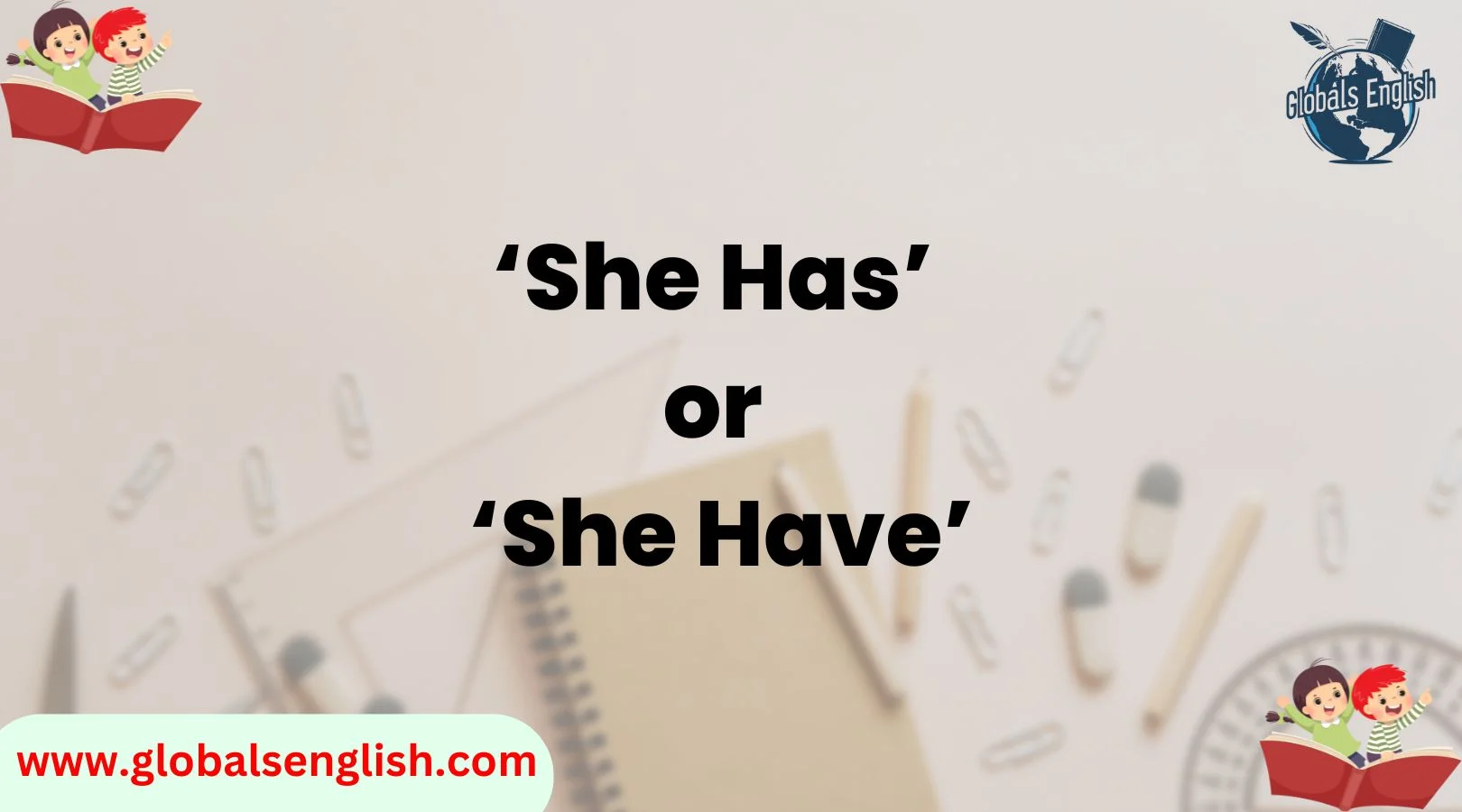The debate between “she has” and “she have” may seem trivial to some, but it’s a topic that confuses many English learners, as well as native speakers, especially in informal settings or dialectical variations.
While the correct answer is straightforward for most people, understanding the grammatical rules behind this difference is essential. After all, speaking and writing with the correct subject-verb agreement is key to sounding clear and credible in any communication.
So, which one is right: she has or she have? The answer isn’t complicated, but it does require a little exploration of how subject-verb agreement works in English.
In this article, we will explore why “she has” is the correct phrase, why some people mistakenly say “she have,” and how to easily identify when to use each form.
We’ll also dive into the broader topic of subject-verb agreement, its importance, and how this issue can be influenced by dialects and informal speech.
Let’s break it down and make it easy to understand!
Understanding the Basics: Has vs. Have
Before we dive into the rules and examples, it’s crucial to understand the basic differences between “has” and “have.” These two words are forms of the verb “to have,” which can function as both a main verb and an auxiliary verb (also known as a helping verb). The confusion often arises because both words are used in different grammatical contexts.
What Does “Has” Mean?
“Has” is the third-person singular form of the verb “to have,” and it is used when the subject is a singular noun or a third-person pronoun (he, she, or it).
Examples of “has” in use:
- She has a new phone.
- He has never been to the park.
- The cat has eaten all the food.
As you can see, “has” is used when the subject is a single person or thing.
What Does “Have” Mean?
On the other hand, “have” is used with plural subjects or with the singular first and second-person pronouns I and you. It is the base form of the verb.
Examples of “have” in use:
- I have a meeting at 3 p.m.
- You have a great sense of humor.
- They have been friends for years.
When the subject is I, you, or they, we always use “have.”
Why Verb Conjugation Matters in English Grammar
In English, verb conjugation is essential for subject-verb agreement. This refers to matching the subject with the correct verb form in terms of number and person.
For example, when the subject is she (a third-person singular pronoun), the correct verb form is “has.” Similarly, when the subject is they (a third-person plural pronoun), the correct verb form is “have.”
Why “She Has” Is the Only Correct Form
Grammar Rule: Third-Person Singular Takes ‘Has’
The key rule that answers our question lies in subject-verb agreement. In English, when the subject is third-person singular (i.e., she, he, or it), the verb must be conjugated with “has.”
For example:
- Correct: She has a dog.
- Incorrect: She have a dog.
The subject “she” is singular, so the verb must be in its third-person singular form, which is “has.”
Remember: If the subject is she, he, or it, the correct verb form is has.
Common Mistakes: Why People Say “She Have”
Many English learners and even native speakers might mistakenly say “she have” instead of “she has” due to influences like informal speech, regional dialects, or misunderstanding the rules.
- Dialect Influence: Some dialects and non-standard English may use “have” in place of “has.”
- Misunderstanding of Conjugation: People might use “have” because they’re thinking of the verb “to have” in its base form, which appears with plural subjects or the pronouns I and you.
For example, a sentence like “She have a dog” might be heard in colloquial speech, but it is grammatically incorrect. The right way is to say “She has a dog.”
How to Identify When to Use “Has” or “Have” in a Sentence
Knowing when to use “has” or “have” is simple once you understand the subject. Here’s a foolproof way to figure out which one to use:
Check the Subject First
The subject will determine which verb form to use. If the subject is she, he, or it, use “has.” For any other subject, use “have.”
Quick Reference:
| Subject | Correct Verb | Example |
| I | have | I have a lot of work to do. |
| You | have | You have a great idea! |
| She/He/It | has | She has a new car. |
| We/They | have | They have visited that museum. |
Recognizing Tense and Helping Verbs
Besides the present simple tense, “have” and “has” are used as helping verbs in compound tenses like the present perfect.
For example:
- She has finished her homework. (present perfect tense)
- They have gone home. (present perfect tense)
The structure is the same for all subjects when we use the present perfect, but we still need to match the verb with the subject.
Examples in Different Tenses
Simple Present Tense
In the simple present tense, “has” is used for third-person singular subjects, while “have” is used for all other subjects.
- She has a pen.
- I have a meeting at 10 a.m.
- They have been friends for years.
Present Perfect Tense
The present perfect tense uses “have” and “has” to describe actions that have been completed in the past but have relevance to the present.
- She has written the report.
- We have completed the task.
- They have lived here for five years.
Negative Sentences and Questions: A Special Note
Forming Negative Sentences
In negative sentences, “have” becomes “have not” (or “haven’t”) or “has not” (or “hasn’t”) depending on the subject.
- She hasn’t finished her homework.
- I haven’t seen that movie.
- They haven’t arrived yet.
Notice that “she” still requires “has” in the negative form, so “hasn’t” is used here.
Asking Questions with ‘Has’ and ‘Have’
To ask questions, you must invert the subject and the verb. This is true for both “has” and “have.”
- Has she gone to the store?
- Have you finished your work?
- Have they been to Paris?
In all cases, the inversion creates a question, and the verb remains matched with the subject.
Regional and Informal Usage: Is “She Have” Ever Acceptable?
Dialect and Non-Standard English
In some regions, particularly in informal contexts or specific dialects, you may hear “she have” used instead of “she has.”
For instance, certain varieties of African American Vernacular English (AAVE) might use “she have” as part of the dialect.
Example: In AAVE, you might hear: “She have been there before.”
While “she have” isn’t grammatically standard, it’s important to understand the context. Dialects and non-standard speech have their own set of rules and should not be considered “incorrect” in those specific contexts.
When Grammar Meets Culture
In informal settings, it’s crucial to decide whether you should correct the usage or simply understand it. Recognizing regional dialects or the influence of pop culture can help you navigate these differences more gracefully.
Teaching and Learning Tip: How to Never Mix These Up Again
Memory Tricks
One of the easiest ways to remember the difference between “has” and “have” is by using a simple mnemonic:
- S in “she” = S in “has.”
This will remind you that when you’re talking about she, he, or it, you’ll always use “has”.
Real-Life Practice
- Exercise: Look at random sentences in books, articles, or websites. Try identifying whether the correct form of the verb is “has” or “have.”
- Quiz: Rewrite sentences with incorrect verb forms (e.g., “she have a dog”), and change them to the correct form (e.g., “she has a dog”).
Quick Reference Table: “Has” vs. “Have”
| Subject | Correct Verb | Example |
| I | have | I have a lot of books. |
| You | have | You have a great idea. |
| She/He/It | has | She has a beautiful dress. |
| We/They | have | They have finished the project. |
Common Phrases Using “She Has” or “She Have”
Correct Idiomatic Expressions
- She has a lot on her plate.
- She has been working nonstop.
- She has a good sense of humor.
Incorrect But Common Expressions
You might hear informal phrases like “She have no idea”, but this is grammatically incorrect. The proper version would be “She has no idea.”
Conclusion
In conclusion, the correct phrase is always “she has” when referring to a third-person singular subject like she. It’s essential to grasp the rule of subject-verb agreement to avoid mistakes like “she have.”
Understanding how “has” works in grammar will help you improve your writing and speaking skills and ensure clarity in communication.
By practicing these concepts and paying attention to the subject-verb agreement in everyday language, you’ll be able to use “has” and “have” correctly in no time.
Frequently Asked Questions (FAQs)
1. Why is it “she has” and not “she have”?
In English, subject-verb agreement is essential, meaning the verb must match the subject in number and person. When the subject is third-person singular, like “she,” the correct form of the verb is “has”. “Have” is used with plural subjects or first- and second-person pronouns, such as “I” and “you.”
2. Can I use “she have” in informal speech?
While “she have” may be heard in some informal speech or dialects (like African American Vernacular English), it is grammatically incorrect in standard English. In formal writing and speech, always use “she has.”
3. What is the difference between “have” and “has”?
“Have” is the base form of the verb “to have” and is used with I, you, we, and they. “Has” is the third-person singular form of “to have” and is used with he, she, and it.
4. How do I know when to use “have” vs. “has”?
The rule is simple: If the subject is singular (such as she, he, or it), use “has.” If the subject is plural (like we, you, or they), or I, use “have.”
5. Can I ever use “have” instead of “has” in formal writing?
No, in formal writing, “she has” is always correct. Using “she have” in formal settings would be considered a grammatical error. It’s important to stick to subject-verb agreement rules in professional contexts.

Emma Brooke is the author and creator behind Globals English, a platform dedicated to helping learners master the English language. With a passion for education and communication, Emma brings years of experience in language teaching and curriculum development. Her mission is to make English learning accessible, engaging, and effective for students worldwide.
